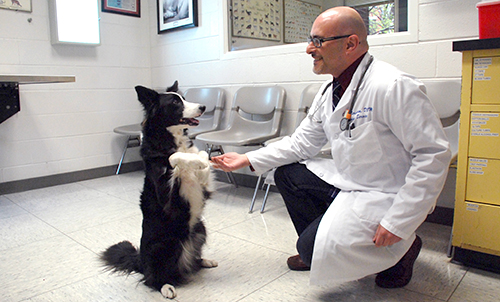Many pet owners may find the behavior of their dogs and cats something of a mystery. Why does their dog bark at shadows on the wall? Why does their cat insist on sitting on the newspaper during breakfast? The desire to understand such seeming oddities becomes more urgent when the behaviors are dangerous or troublesome, such as when a dog begins acting aggressively to visitors or a cat stops using the litter box.
Researchers and clinicians at Penn Vet have been working for decades to help pet owners interpret and, in some cases, modify their animals’ behaviors. Now, innovative initiatives from the Behavior Medicine Service and the Center for the Interaction of Animals and Society are furthering that understanding. The new Fe-BARQ behavioral questionnaire for cats, the previously developed C-BARQ for dogs, and a soon-to-be-piloted web portal for behavior medicine education and consultation are all aimed at bettering the lives of pets and their owners alike.
 Back in 2003, Dr. James Serpell, Director of Penn Vet’s Center for the Interaction of Animals and Society, wanted to gather data about dog behavior for use in his research. Since it wasn’t practical to go into hundreds of homes to observe how dogs behaved, he decided to do the next best thing: ask the owners.
Back in 2003, Dr. James Serpell, Director of Penn Vet’s Center for the Interaction of Animals and Society, wanted to gather data about dog behavior for use in his research. Since it wasn’t practical to go into hundreds of homes to observe how dogs behaved, he decided to do the next best thing: ask the owners.
The result was C-BARQ, short for Canine Behavioral Assessment and Research Questionnaire, a 100-question survey aimed at pet owners, trainers, working dog and rescue organizations, breeders, and veterinarians. The response to C-BARQ far exceeded Serpell’s initial hopes.
“To my surprise and delight, C-BARQ was extremely successful among pet owners, who wanted to know more about their dogs’ behavior. And it has also been taken up by the research community,” he said.
To date, the questionnaire and its results have been used in more than 60 published scientific studies, with more than 30,000 pet dogs and a similar number of working dogs in the database.
Recently, Serpell decided to take the next logical step: develop a behavioral evaluation questionnaire for cats. This year, he unveiled the feline equivalent to the C-BARQ, the Feline Behavioral Assessment and Research Questionnaire, or Fe-BARQ, developed with support from the WALTHAM Foundation. To assemble a set of questions appropriate for felines, however, he and his team had to start from scratch.

“It was an interesting process,” he remarked. After scouring the scientific literature and asking half a dozen cat behavior experts worldwide to review an early draft, it became apparent that analyzing cat behavior comes with a unique set of challenges.
“With dogs, it’s very clear what kind of behaviors are positive and what behaviors are negative,” Serpell noted. “No one likes excessive barking, for example. With cats, it’s not as clear. I suspect some owners are happy with a cat that doesn’t climb the furniture, while other people would be delighted to have a very active, playful cat.”
What’s more, cat behaviors didn’t fall into the same neat categories that dog behaviors did. In analyzing C-BARQ, the researchers came up with 14 distinct factors, or sets of related behaviors. For Fe-BARQ, responses grouped into nearly two dozen discrete factors, an indication that the behaviors of individual cats aren’t easily categorized. A cat that purrs constantly, for instance, may not be any more likely to be sociable than a cat that rarely purrs.
Despite the complexities of analyzing cat behavior, Serpell and colleagues are already beginning to identify patterns using initial data from the Fe-BARQ. A paper by the group published earlier this spring in the Journal of Veterinary Behavior showed a strong association between breed and behaviors such as aggression toward other cats or separation-related problems.
Both the Fe-BARQ and C-BARQ are available online. After completing the questionnaire about a pet, respondents receive a report with assessments of a cat’s scores compared to the breed average in various categories such as activity/playfulness, sociability with people, and sociability with other animals.
The reports provide a good deal of interesting data, but don’t provide guidance about what a pet owner is to do if a certain type of behavior is a problem.
“The C-BARQ and Fe-BARQ are not diagnostic tools,” said Dr. Carlo Siracusa, Director of Penn Vet’s Behavior Medicine Service. “They tell you how your dog or cat compares with the average population in relation to some temperament traits.”

To take the next step requires a more individualized approach. That’s where a new web portal will come in. Serpell and Siracusa have been working with the company Connect for Education to build a website that will provide pet owners and primary care veterinarians with quality behavioral information and the specialized services of Penn Vet’s behavior experts.
The idea for the portal emerged several years ago. Dongsook Whitehead, the President, CEO, and chief instructional designer of Connect for Education, had been hearing rave reviews about Serpell and Siracusa from her daughter, KimMi Whitehead, V’10. Whitehead approached Serpell to inquire about a possible partnership between the school and her company, which produces web-based instructional materials and services. Together, they envisioned an online tool for offering behavioral consulting services.
The concept took a few years to move forward, but Whitehead, Serpell, and Siracusa are now formalizing a web portal pilot effort set to launch this fall.
Their vision is to build upon the information and services already in place at Penn Vet. While the Behavior Medicine Service has informational sheets online on topics such as house training a new dog or interpreting a pet’s body language, the portal will allow pet owners to take one of the questionnaires and receive information and links to videos that are tailored to their concerns about their cat or dog.
“The portal is going to be allencompassing,” explained Whitehead. “We’re hoping that people can use the portal to do everything from taking an assessment using C-BARQ or Fe-BARQ, to getting relevant articles and video clips, all the way to uploading videos of a pet’s behaviors and getting time-stamped feedback from a behavioral veterinarian.”
The portal’s clinician-facing side would enable primary care veterinarians to upload medical records and provide videos of patients to Penn Vet’s board-certified behavior experts. In addition to expanding access to veterinarians and clients, Siracusa would like to add a service for animal shelters to help improve the conditions and welfare of animals under their care.
“One thing we stress a lot is the need to provide people, both primary care veterinarians and laypeople, with science-based information,” Siracusa said. “There is a lot of what I call ‘pop behavior culture’ with a lot of incorrect and often dangerous information. We want people to have the opportunity to go online, see the Penn Vet name, and know that this is a trusted source of information.”